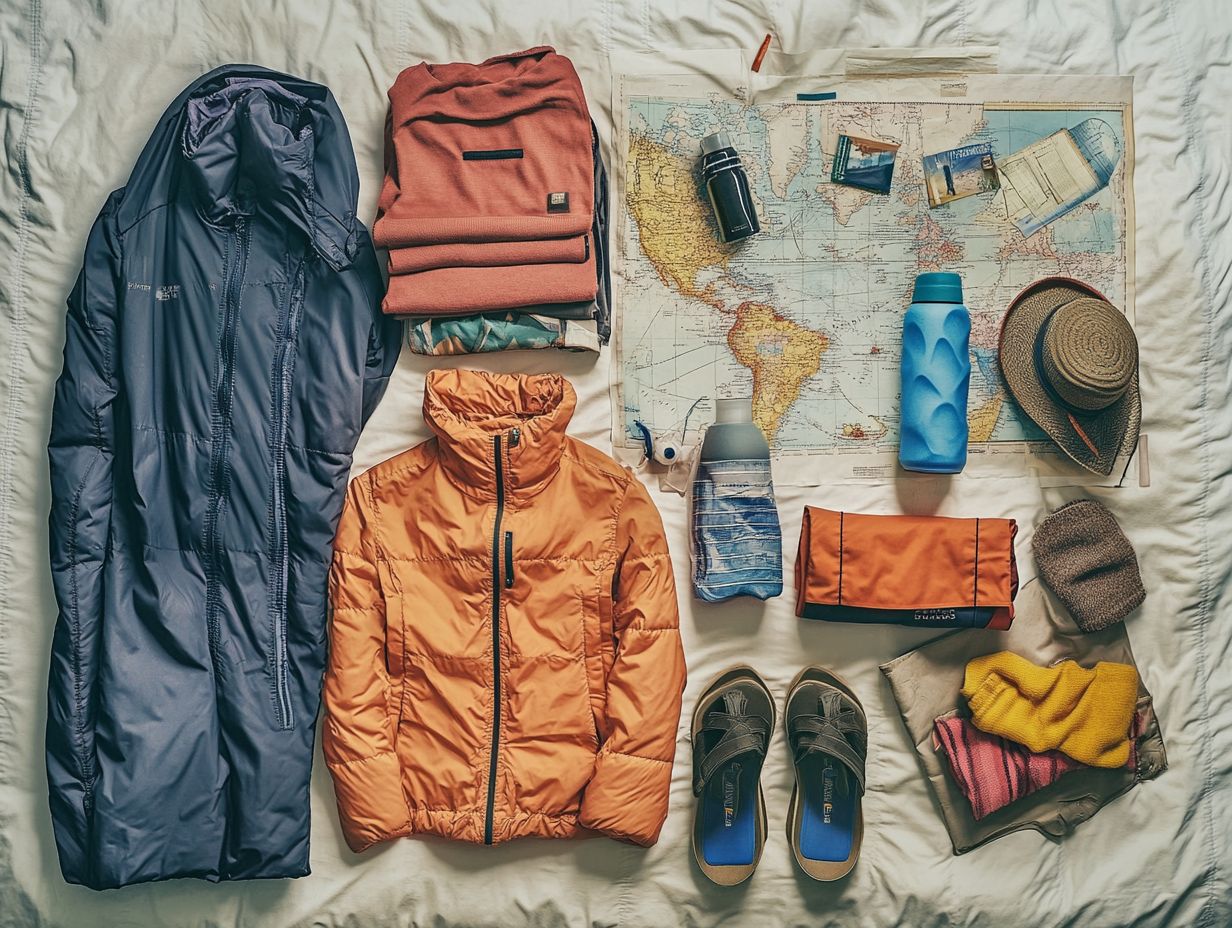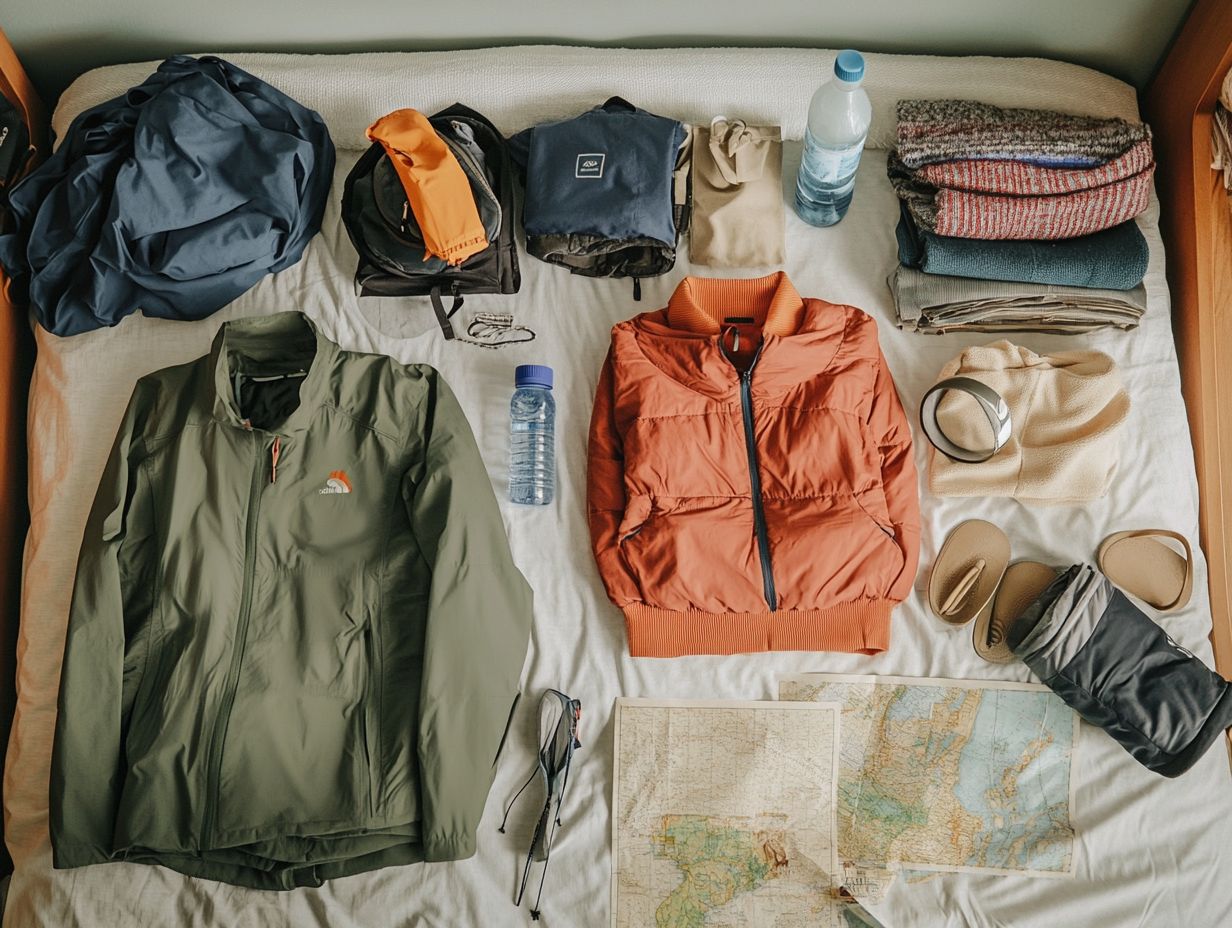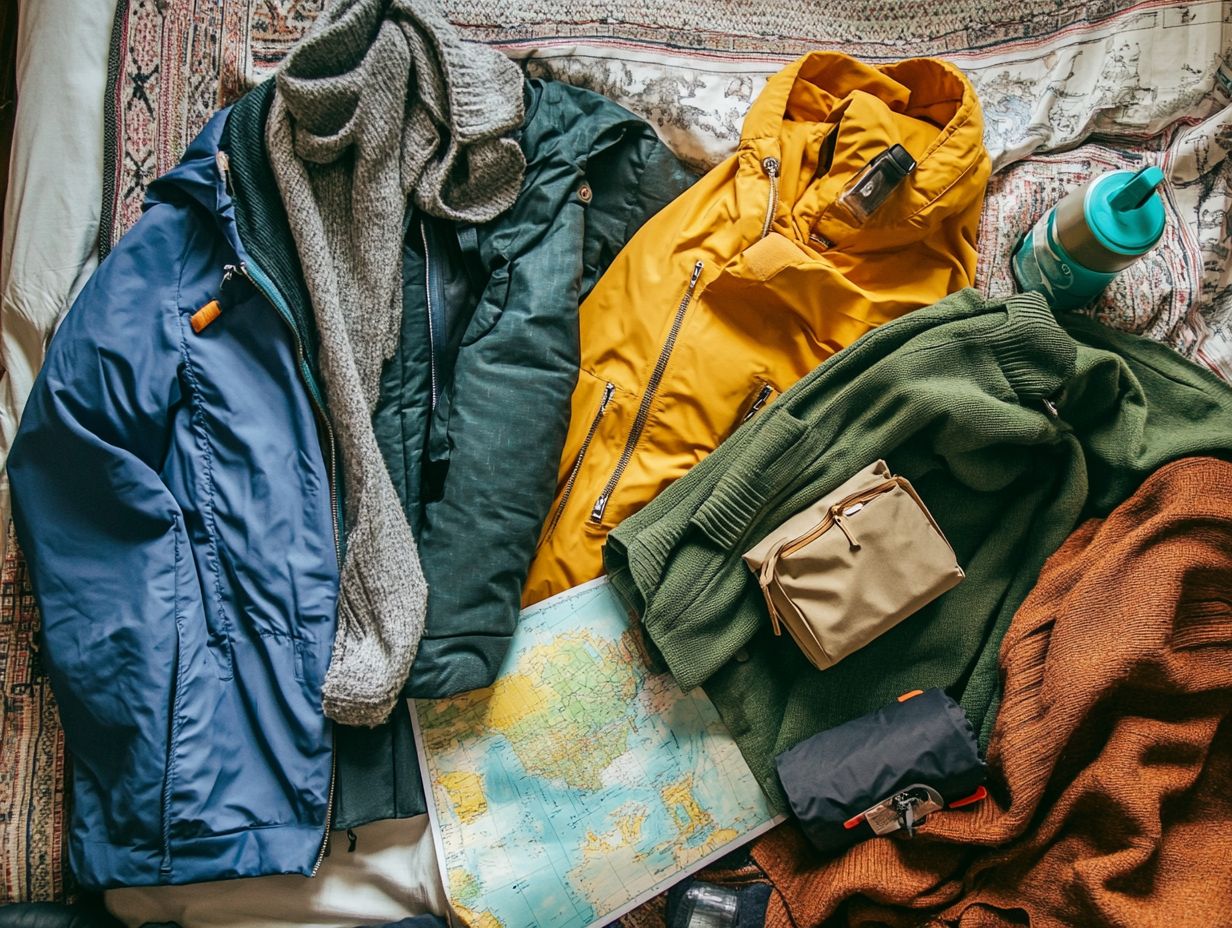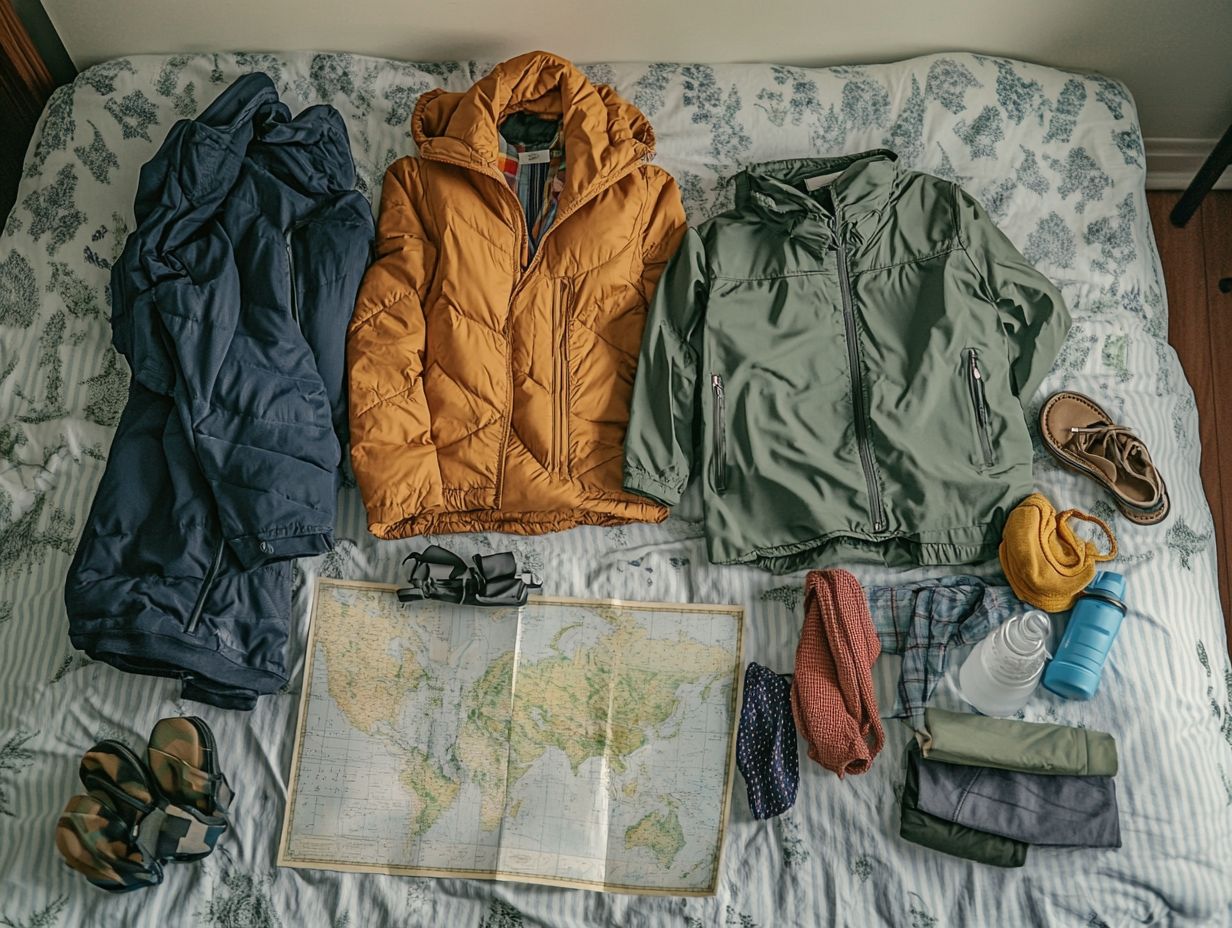Packing for Different Climates: Student Guide
When it comes to traveling or relocating, understanding the weather of your destination is absolutely essential. Each climate brings its own set of challenges that can significantly impact your comfort and overall well-being.
This guide explores various types of climates and their distinct characteristics. You’ll be thoroughly prepared for any journey ahead. From must-have packing lists to carefully selected clothing and accessories for hot, cold, wet, or ever-changing climates, you ll discover everything you need.
Get ready to pack smartly and start your adventure with unparalleled comfort!
Contents
- Key Takeaways:
- Understanding Different Climates
- Essential Items for All Climates
- Packing for Hot and Humid Climates
- Packing for Cold and Dry Climates
- Packing for Wet and Windy Climates
- Packing for Changing Climates
- Frequently Asked Questions
- What is the best way to pack for a trip to different climates?
- What are some essential items to pack for a trip to different climates?
- How can I save space when packing for different climates?
- Should I pack any emergency items when traveling to different climates?
- How can I protect my belongings when traveling to different climates?
- What should I consider when packing for a trip to different climates as a student?
Key Takeaways:

- Know your climate: Understand what kind of weather to expect.
- Pack smart: Include versatile items like jackets and shoes.
- Tailor your clothing: Choose pieces that suit your destination.
Understanding Different Climates
Understanding the various climates you may encounter is crucial for effective packing and ensuring your comfort during travels. Whether you’re basking in the sun on Croatia’s beaches, braving the chill of the Austrian Alps, or wandering through the temperate landscapes of Slovenia, each climate presents its own set of challenges and packing needs.
Selecting the right clothing styles and accessories tailored to specific weather conditions can enhance your travel experience. Consider factors like temperature, humidity, and precipitation to make a packing list that includes lightweight, comfortable layers and essential items for different climates.
By preparing well, you can enjoy your travels without the worry of unsuitable clothing.
Types of Climates and Their Characteristics
Different types of climates possess unique characteristics that can profoundly influence your travel experiences, affecting your choice of clothing and packing essentials.
For example, in tropical climates characterized by humidity and warmth, lightweight, breathable fabrics (materials that allow air to pass through and keep you cool) become essential for your comfort. Conversely, arid regions present a challenge with extreme heat during the day and cooler temperatures at night, requiring you to pack versatile clothing layers that can be easily adjusted.
In temperate zones, the variety of weather conditions demands careful selection of garments that transition seamlessly from warm to cool temperatures. Meanwhile, polar climates dictate the need for thermal, insulated wear to keep you comfortable in frigid conditions, emphasizing functionality to tackle harsh environments effectively during your travels.
Essential Items for All Climates
Creating a universal packing list that covers essential items for every climate is vital for a seamless travel experience. This preparation ensures that you are ready to tackle any situation that may arise, allowing you to travel with confidence and ease.
Universal Packing List
A universal packing list should include versatile clothing items that accommodate a range of climates and travel destinations, ensuring you’re ready for whatever weather comes your way.
To create this packing list effectively, consider layering techniques and your choice of fabrics. Lightweight sweaters, breathable cotton shirts, and a high-quality jacket are perfect for layering, allowing you to adapt to fluctuating temperatures easily.
Don t forget to include a pair of comfortable jeans, versatile trousers, and a stylish yet functional dress; these pieces transition effortlessly from casual sightseeing to a more formal dinner.
When it comes to shoes, prioritize comfort; a sturdy pair of walking shoes paired with elegant flats or loafers will serve you well.
Accessories like scarves and hats not only elevate your style but also provide warmth, making them essential for adapting to different environments.
Packing for Hot and Humid Climates

Packing for hot and humid climates requires selecting clothing that combines comfort and style. You want to be prepared for outdoor adventures.
Find that perfect balance to enjoy the warmth while looking effortlessly chic.
Recommended Clothing and Accessories
Prioritize lightweight and breathable clothing for comfort and to help regulate body temperature.
Include essentials like shorts and tank tops. These can be layered with breathable dresses for added versatility.
Accessorize with wide-brimmed hats and stylish sunglasses. They protect you from the sun and enhance your outfits.
Packing for Cold and Dry Climates
Packing for cold and dry climates means learning to layer with warm fabrics. This keeps you comfortable while adapting to changing weather.
Recommended Clothing and Accessories
Choose clothing that offers warmth without sacrificing style. Layering is key.
Start with stylish, warm jeans. An insulated jacket keeps the chill away and looks great.
Warm socks are essential too. They keep your feet cozy, especially with supportive travel shoes.
Don t forget gloves and scarves. They add flair and keep you warm.
Packing for Wet and Windy Climates
For wet and windy climates, focus on waterproof clothing and versatile accessories. Stay dry and comfortable on your adventures.
Recommended Clothing and Accessories

Choose a high-quality waterproof jacket to protect against the elements. Travel shoes with a good grip help you navigate slippery surfaces.
A water-resistant bag is essential to keep your belongings dry. Layer your clothing to adapt to temperature changes.
Don t overlook accessories like a snug beanie and waterproof gloves. They provide warmth and protection.
Packing for Changing Climates
Packing for varying climates requires a thoughtful approach. Use versatile layers for easy adjustments to changing weather.
Tips for Layering and Versatility
Mastering the art of layering is crucial for packing effectively in ever-changing climates. This approach allows you to adjust your clothing easily as temperatures shift from warm to cold.
By understanding the importance of base, mid, and outer layers, you can create a versatile wardrobe that adapts seamlessly to various weather conditions. The base layer, which sits directly against your skin, should be made of fabric that draws sweat away from your body to keep you dry and comfortable. Next is the mid-layer, designed to provide insulation without adding unnecessary bulk. Finally, the outer layer serves as your shield against wind and rain, ensuring that unexpected elements don t disrupt your outdoor adventures.
Choosing versatile travel shoes that balance comfort and style is essential. Smartly accessorizing lets you navigate changing environments effortlessly.
Frequently Asked Questions
What is the best way to pack for a trip to different climates?
The best way to pack is to plan ahead and check the weather forecast for each destination. This helps you determine the clothing and accessories needed for each location.
What are some essential items to pack for a trip to different climates?

Essential items include versatile clothing such as layering pieces, a waterproof jacket, comfortable walking shoes, and a hat. Also, pack sunscreen, insect repellent, and any necessary medications.
How can I save space when packing for different climates?
To save space, pack items that serve multiple purposes. For example, a lightweight scarf can act as a cover-up in warm weather and as a layering piece in colder climates. Rolling your clothes instead of folding them can also help maximize space in your luggage.
Should I pack any emergency items when traveling to different climates?
Packing emergency items is a smart move! These may include a first aid kit, a small flashlight, and a travel-sized umbrella. It’s better to be prepared for unexpected situations than to be caught without essential supplies.
How can I protect my belongings when traveling to different climates?
Invest in sturdy and waterproof luggage or a suitcase. Use packing cubes or plastic bags to keep your clothes organized and protected from spills or leaks. Consider purchasing travel insurance for extra peace of mind.
What should I consider when packing for a trip to different climates as a student?
As a student, budget and practicality are key factors. Look for affordable yet high-quality clothing and accessories that serve multiple purposes. Pack versatile items that can be dressed up or down to minimize the amount of clothing needed.
Get ready for your next adventure by packing wisely for any climate!





